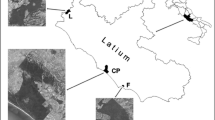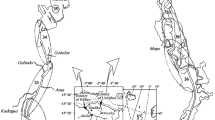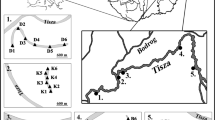Abstract
Microcrustacean assemblages (Cladocera and Copepoda) from astatic ponds and pools of Castelporziano Presidential Estate were analysed to evaluate their role as indicators of functional variations related to the duration of the wet phase. Samples from a subset of 23 water bodies classified as permanent or temporary (based on observations over two decades, 1989–2010) were analysed. As a whole, 36 species of microcrustaceans were present. Hierarchical clustering allowed a clear distinction between temporary and permanent water bodies. Principal coordinates analysis (PCoA) provided a good separation of the two major hydroperiod groups along the first axis, while no correlation emerged among PCoA axes and hydrogeological setting. The correlation between species and the first PCoA axis highlighted biological indicators of hydrological change: among them, the cyclopoid copepods Macrocyclops albidus and Eucyclops serrulatus, which have no resting stages, were exclusive of permanent ponds; the calanoid copepod Eudiaptomus padanus etruscus and the cladocerans Ceriodaphnia reticulata, Scapholeberis rammneri and Coronatella rectangula were present in permanent and semi-permanent ponds; the cladoceran Daphnia chevreuxi and the calanoid copepods Diaptomus serbicus, Hemidiaptomus gurneyi and Mixodiaptomus kupelwieseri were exclusive of temporary ponds with short hydroperiod (less than 6 months). Temporary water bodies hosted a higher mean species richness (13.7 species) than permanent ones (10.3), and the difference was statistically significant. Our results highlight that: (1) the cladoceran and copepod assemblage effectively discriminate between ponds with different wet phase duration, proving to be good bioindicator; (2) small astatic water bodies play an important role in biodiversity conservation, as they host a high percentage of the species distributed over wider areas, next to species which are exclusively found in these habitats; (3) hydroperiod appears to be the main driving force in characterising microcrustacean assemblages in astatic ponds.






Similar content being viewed by others
References
Accademia Nazionale delle Scienze, Roma (ed) (2001) Il Sistema Ambientale della Tenuta Presidenziale di Castelporziano, vol I e II. Scritti e Documenti XXVI
Anderson MJ (2005) PERMANOVA: A FORTRAN computer program for permutational multivariate analysis of variance. Department of Statistics, University of Auckland, Auckland
Anton-Pardo M, Armengol X (2010) Zooplankton community from restored peridunal ponds in the Mediterranean region (Albufera Natural Park, Valencia, Spain). Limnetica 29(1):133–144
Bazzanti M, Seminara M, Baldoni S (1997) Chironomids (Diptera: Chironomidae) from three temporary ponds of different wet phase duration in Central Italy. J Freshw Ecol 12(1):89–100
Céréghino R, Biggs J, Oertli B, Declerck S (2008) The ecology of European ponds: defining the characteristics of a neglected freshwater habitat. Hydrobiologia 597:1–6
Clarke KR, Gorley RN (2006) PRIMER v6.1: User Manual/Tutorial. PRIMER-E, Plymouth
Colwell RK (2005) EstimateS: Statistical estimation of species richness and shared species from samples, version 9.1. Available at http://purl.oclc.org/estimates
De Bie T, Declerck S, Martens K, De Meester L, Brendonck L (2008) A comparative analysis of cladoceran communities from different water body types: patterns in community composition and diversity. Hydrobiologia 597:19–27
Dimitriou E, Moussoulis E, Stamati F, Nikolaidis N (2009) Modelling hydrological characteristics of Mediterranean Temporary Ponds and potential impacts from climate change. Hydrobiologia 634(1):195–208
Einsle U (1993) Crustacea Copepoda. Calanoida and Cyclopoida. G. Fischer Verlag, Jena, p 228
Fahd K, Florencio M, Keller C, Serrano L (2007) The effect of the sampling scale on zooplankton community assessment and its implications for the conservation of temporary ponds in southwest Spain. Aquat Conserv Marine Freshw Ecosyst 17(2):175–193
Fricano F, Neri U, Scandella P, Di Blasi N, Mecella G (2001) Studio del sistema di alimentazione di invasi naturali in un particolare ambiente umido costiero mediterraneo. In: Accademia Nazionale delle Scienze, Roma (ed) Il Sistema Ambientale della Tenuta Presidenziale di Castelporziano. Scritti e Documenti XXVI: pp 99–109
Fryer G (1993) The freshwater Crustacea of Yorkshire: a faunistical and ecological survey. Yorkshire Naturalist’s Union & Leeds Philosophical and Literary Society, pp 312
Gopal B, Junk WJ, Davis JA (eds) (2000) Biodiversity in wetlands: assessment, function and conservation, vol I. Backhuys Publishers, Leiden, p 354
Gopal B, Junk WJ, Davis JA (eds) (2001) Biodiversity in wetlands: assessment, function and conservation, vol II. Backhuys Publishers, Leiden, p 311
Gotelli NJ, Colwell RK (2001) Quantifying biodiversity: procedures and pitfalls in the measurement and comparison of species richness. Ecol Lett 4:379–391
Margaritora FG (1985) Cladocera. Fauna Italia Calderini Bologna 23:1–399
Margaritora FG (2005) Crustacea Branchiopoda Cladocera. In: Ruffo S, Stoch F (eds) Checklist e distribuzione della fauna italiana. Memorie del Museo Civico di Storia Naturale di Verona, 2.serie, Sezione Scienze della Vita, 16: pp 87–89 + CD-ROM
Margaritora FG, Vagaggini D (2007) Zooplantcton. In: Laghi vulcanici—il fuoco, l’acqua e la vita, a cura di Stoch F. Collana Quaderni Habitat 17: pp 67–77
Marrone F, Castelli G, Naselli-Flores L (2009) Sicilian temporary ponds: an overview of the composition of their crustacean biota. In: Fraga i Arguimbau P (ed) International Conference on Mediterranean Temporary Ponds. Proceedings & Abstracts. Consell Insular de Menorca. Recerca, 14. Maó, Menorca, pp 111–129
Mecella G, Scandella P, Fricano F, Pizzoferrato MC, Di Blasi N, Moretti R (1998) Monitoraggio delle piscine 1997–1998. In: Progetto di monitoraggio Ambientale della Tenuta Presidenziale di Castelporziano (SITAC). Rapporto 1998. pp 193–200
Oertli B, Biggs J, Céréghino R, Grillas P (2005) Conservation and monitoring of pond biodiversity: introduction. Aquat Conserv Marine Freshw Ecosyst 15(6):535–540
Pizzoferrato MC, Neri U, Mecella G, Scandella P, Di Blasi N (2001) Applicazioni di tecniche statistiche multivariate per la caratterizzazione del chimismo delle acque di invasi naturali in un ambiente umido costiero. In: Accademia Nazionale delle Scienze, Roma (Ed): Il Sistema Ambientale della Tenuta Presidenziale di Castelporziano. Scritti e Documenti XXVI, pp 111–120
Sahuquillo M, Miracle MR (2013) The role of historic and climatic factors in the distribution of crustacean communities in Iberian Mediterranean ponds. Freshw Biol 58:1251–1266
Scandella P, Mecella G, Fricano F, Bucci M, Pizzoferrato MC (1999) Ambiente idrico della Tenuta Presidenziale di Castelporziano. Boll della Soc Ital della Sci del Suolo 48(2):359–368
Seminara M, Vagaggini D, Margaritora FG (2008) Differential responses of zooplankton assemblages to environmental variation in temporary and permanent ponds. Aquat Ecol 42:129–140
Serrano L, Fahd K (2005) Zooplankton communities across a hydroperiod gradient of temporary ponds in the Donana National Park (Sw Spain). Wetlands 25(1):101–111
Smith ND, Golladay FW (2011) Coleoptera indicator species in wet vs. dry climate regimes in three southwestern Georgia wetland types. Proceedings of the 2011 Georgia Water Resources Conference, University of Georgia
Stella E (1984) Copepoda: calanoida d’acqua dolce. Fauna Ital Calderini Bologna 21:1–101
Stoch F (2005a) Crustacea Copepoda Calanoida. In: Ruffo S, Stoch F (ed) Checklist e distribuzione della fauna italiana. Memorie del Museo Civico di Storia Naturale di Verona, 2.serie, Sezione Scienze della Vita 16, pp 91–92 + CD-ROM
Stoch F (2005b) Crustacea Copepoda Cyclopoida. In: Ruffo S, Stoch F (ed) Checklist e distribuzione della fauna italiana. Memorie del Museo Civico di Storia Naturale di Verona, 2.serie, Sezione Scienze della Vita, 16, pp 93–95 + CD-ROM
Stoch F, Naselli-Flores L (2014) Acque temporanee: biodiversità, funzioni ecosistemiche, vulnerabilità e sensibilità ai cambiamenti climatici. Biol Ambient 28(2):87–92
Tiner RW (1999) Wetland indicators. A guide to wetland identification, delineation, classification, and mapping. Lewis Publishers, Boca Raton, p 392
Vagaggini D, Ulisse G, Seminara M, Margaritora FG (2002) Zooplankton communities in two astatic basins in the natural reserve of Castelporziano (Central Italy): composition and temporal succession. J Freshw Ecol 17:27–36
Williams DD (1999) Conservation of wetlands in drylands: a key global issue. Aquat Conserv Marine Freshw Ecosyst 9:517–522
Author information
Authors and Affiliations
Corresponding author
Additional information
This peer-reviewed article is a result of the multidisciplinary project coordinated by the “Accademia Nazionale delle Scienze detta dei XL”, Rome, Italy, in the area of the presidential estate of Castelporziano near Rome.
Rights and permissions
About this article
Cite this article
Seminara, M., Vagaggini, D. & Stoch, F. Long-term monitoring of astatic water bodies: microcrustaceans as indicators of hydroperiod length in ponds and pools. Rend. Fis. Acc. Lincei 26 (Suppl 3), 345–352 (2015). https://doi.org/10.1007/s12210-015-0406-5
Received:
Accepted:
Published:
Issue Date:
DOI: https://doi.org/10.1007/s12210-015-0406-5




